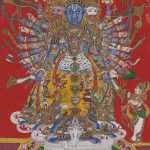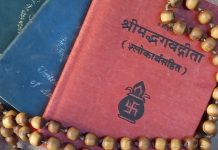by Sri Nandanandana das (Stephen Knapp)
It is amazing how much Western science has taught us. Today, for example, kids in grammar school learn that the sun is 93 million miles from the earth and that the speed of light is 186,000 miles per second. Yoga may teach us about our Higher Self, but it can’t supply this kind of information about physics or astronomy.
Or can it?
Professor Subhash Kak of Louisiana State University referred to the statement by Sayana, a fourteenth century Indian scholar. In his commentary on a hymn in the Rig Veda, the oldest and perhaps most mystical text ever composed in India, Sayana has this to say: “With deep respect, I bow to the sun, who travels 2,202 yojanas in half a nimesha.”
A yojana is about nine American miles; a nimesha is 16/75 of a second. 2,202 yojanas x 9 miles x 75/8 nimeshas = 185,794 m. p. s.
Basically, Sayana is saying that sunlight travels at 186,000 miles per second! How could a Vedic scholar who died in 1387 A. D. have known the correct figure for the speed of light? If this was just a wild guess, it’s the most amazing coincidence in the history of science!
The yoga tradition is full of such coincidences. Take for instance the mala many yoga students wear around their neck. Since these rosaries are used to keep track of the number of mantras a person is repeating, students often ask why they have 108 beads instead of 100. Part of the reason is that the mala represent the ecliptic, the path of the sun and moon across the sky. Yogis divide the ecliptic into 27 equal sections called nakshatras, and each of these into four equal sectors called paadas, or “steps,” marking the 108 steps that the sun and moon take through heaven.
Each is associated with a particular blessing force, with which you align yourself as you turn the beads.
Traditionally, yoga students stop at the 109th “guru bead,” flip the mala around in their hand, and continue reciting their mantra as they move backward through the beads. The guru bead represents the summer and winter solstices, when the sun appears to stop in its course and reverse directions. In the yoga tradition we learn that we’re deeply interconnected with all of nature. Using a mala is a symbolic way of connecting ourselves with the cosmic cycles governing our universe.
The mala of 108 beads also represents Krishna, as the head bead, and His 108 most confidential servants. So you chant on all the beads except the Krishna bead, which you turn the mala around and chant the other ways for another “round” of 108 times of chanting. It can also represent the 108 most important of the Upanishads.
But Professor Kak points out yet another coincidence: The distance between the earth and the sun is approximately 108 times the sun’s diameter. The diameter of the sun is about 108 times the earth’s diameter. And the distance between the earth and the moon is 108 times the moon’s diameter.
Could this be the reason the ancient sages considered 108 such a sacred number? If the microcosm (us) mirrors the macrocosm (the solar system), then maybe you could say there are 108 steps between our ordinary human awareness and the divine light at the center of our being. Each time we chant another mantra as our mala beads slip through our fingers, we are taking another step toward our own inner sun.
As we read through ancient Indian texts, we find so much the sages of antiquity could not possibly have known-but did. While our European and Middle Eastern ancestors claimed that the universe was created about 6,000 years ago, the yogis have always maintained that our present cosmos is billions of years old, and that it’s just one of many such universes which have arisen and dissolved in the vastness of eternity.
In fact, the Puranas, encyclopedias of yogic lore thousands of years old, describe the birth of our solar system out of a “milk ocean,” the Milky Way. Through the will of the Creator, they tell us, a vortex shaped like a lotus arose from the navel of eternity. It was called Hiranya Garbha, the shining womb. It gradually coalesced into our world, but will perish some day billions of years hence when the sun expands to many times its present size, swallowing all life on earth. In the end, the Puranas say, the ashes of the earth will be blown into space by the cosmic wind. Today we know this is a scientifically accurate, if poetic, description of the fate of our planet.
The Surya Siddhanta is the oldest surviving astronomical text in the Indian tradition. Some Western scholars date it to perhaps the fifth or sixth centuries A. D., though the next itself claims to represent a tradition much, much older. It explains that the earth is shaped like a ball, and states that at the very opposite side of the planet from India is a great city where the sun is rising at the same time it sets in India. In this city, the Surya Siddhanta claims, lives a race of siddhas, or advanced spiritual adepts. If you trace the globe of the earth around to the exact opposite side of India, you’ll find Mexico. Is it possible that the ancient Indians were well aware of the great sages/astronomers of Central America many centuries before Columbus discovered America?- the Mayans or Incas.
Knowing the unknowable: To us today it seems impossible that the speed of light or the fate of our solar system could be determined without advanced astronomical instruments.
How could the writers of old Sanskrit texts have known the unknowable? In searching for an explanation we first need to understand that these ancient scientists were not just intellectuals, they were practicing yogis. The very first lines of the Surya Siddhanta, for of the Golden Age a great astronomer named Maya desired to learn the secrets of the heavens, so he first performed rigorous yogic practices. Then the answers to his questions appeared in his mind in an intuitive flash.
Does this sound unlikely? Yoga Sutra 3:26-28 states that through, samyama (concentration, meditation, and unbroken mental absorption) on the sun, moon, and pole star, we can gain knowledge of the planets and stars. Sutra 3:33 clarifies, saying: “Through keenly developed intuition, everything can be known.” Highly developed intuition is called pratibha in yoga. It is accessible only to those who have completely stilled their mind, focusing their attention on one object with laser-like intensity. Those who have limited their mind are no longer limited to the fragments of knowledge supplied by the five senses. All knowledge becomes accessible to them.
“There are [those] who would say that consciousness, acting on itself, can find universal knowledge,” Professor Kak admits. “In fact this is the traditional Indian view.”
Perhaps the ancient sages didn’t need advanced astronomical instruments. After all, they had yoga.
Further Significance of the Number 108 in Vedic Culture
Indian culture has a very special significance for Number 108. What does this number represent, and why is it so important?
One idea is as follows: In one minute, we breathe in approximately 15 times, in 1 hour 900 times, And in 12 hours 10,800 times, and in a day 10,800 * 2 times. A day consists of 24 hours, and if we set aside half the day for our day to day routines. Then one can spend 12 hours for recitation of one’s God. Therefore, it seems that the maximmum number of times that one can recite “mantra”, or perform “Japa” is 10,800. If one wants to obtain 100% benefit of the japa, then performing Jap 108 times will give you the benefit of 100%. That’s why in a “Mala”, There are 108 beads. It is written in Vedas, that 1 japa or “round” corresponds to 1 mala (which has 108 beads), therefore performing japa of 108 malas will result in 100% benefit.
Astronomically, there are 27 constellations in our galaxy, and each one them has 4 directions, and 27 * 4 = 108. In other words the number 108 covers the whole galaxy.
3) According to Indian scriptures, letter 9 corresponds to Lord Brahma (the Creator of universe). Mathematically, the interesting property of 9 is 9×1 = 9
9 x 2 = 18 (8+1 = 9)
9 * 3 = 27 (7+2 = 9)
9 * 12 = 108 (1+0+8 = 9)
The addition of digits of number 108 is 9, and number 9 is related with Brahma, that’s why 108 is very important.
Indian Vedas, treats the Sun as God, and Sun has 12 signs (Zodiac signs). In Yajurveda, the Sun is related with Lord Brahma (the number 9), remember – 12 * 9 = 108; therefore for recitation of the mantra or prayer, the number 108 is very sacred.
According to Vedic scriptures, there are also 4 Yugas
Satya Yuga – consists of 172,800 years (1+7+2+8 = 18 = (1+8 = 9)
Treta Yuga consists of 1296000 years (1+2+9+6 = 18 = (1+8 = 9)
Dwapara Yuga consists of 864000 years (8+4+6) = 18 = (1+8 = 9)
Kaliyuga consists of 432000 years (4+3+2) = 9
Harshad number: 108 is a Harshad number, which is an integer divisible by the sum of its digits (Harshad is from Sanskrit, and means “great joy”)
Desires: There are said to be 108 earthly desires in mortals.
Lies: There are said to be 108 lies that humans tell.
Delusions: There are said to be 108 human delusions or forms of ignorance.
Heart Chakra: The chakras are the intersections of energy lines, and there are said to be a total of 108 energy lines converging to form the heart chakra. One of them, sushumna leads to the crown chakra, and is said to be the path to Self-realization.
Sanskrit alphabet: There are 54 letters in the Sanskrit alphabet. Each has masculine and feminine, Shiva and shakti. 54 times 2 is 108.
Pranayama: If one is able to be so calm in meditation as to have only 108 breaths in a day, enlightenment will come.
Upanishads: Some say there are 108 Upanishads, texts of the wisdom of the ancient sages.
Sri Yantra: On the Sri Yantra there are marmas where three lines intersect, and there are 54 such intersections. Each intersection has masculine and feminine, Shiva and shakti qualities. 54 times 2 equals 108. Thus, there are 108 points that define the Sri Yantra as well as the human body. The angle formed by two adjacent lines in a pentagon equals 108 degrees. Pentagon: The angle formed by two adjacent lines in a pentagon equals 108 degrees.
Marmas: Marmas or marmasthanas are like energy intersections called chakras, except have fewer energy lines converging to form them. There are said to be 108 marmas in the subtle body.
Time: Some say there are 108 feelings, with 36 related to the past, 36 related to the present, and 36 related to the future.
Chemistry: Interestingly, there are about 115 elements known on the periodic table of the elements. Most of those, around or higher than the number 100 only exist in the laboratory, and some for only thousandths of a second. The number that naturally exist on Earth is around 100.
Astrology: There are 12 constellations, and 9 arc segments called namshas or chandrakalas. 9 times 12 equals 108. Chandra is moon, and kalas are the divisions within a whole.
River Ganga: The sacred River Ganga spans a longitude of 12 degrees (79 to 91), and a latitude of 9 degrees (22 to 31). 12 times 9 equals 108.
Planets and Houses: In Vedic astrology, there are 12 houses and 9 planets. 12 times 9 equals 108.
Goddess names: There are said to be 108 major names of the Vedic Gods and Goddesses.
Gopis of Krishna: In the Krishna tradition, there were said to be 108 most important of the gopis or maid servants of Krishna .
1, 0, and 8: Some say that 1 stands for God or higher Truth, 0 stands for emptiness or completeness in spiritual practice, and 8 stands for infinity or eternity.
Sun and Earth: The diameter of the Sun is 108 times the diameter of the Earth. The distance from the Sun to the Earth is 108 times the diameter of the Sun.
Moon and Earth: The average distance of the Moon from the Earth is 108 times the diameter of the Moon.
Silver and the moon: In astrology, the metal silver is said to represent the moon.
Numerical scale: The 1 of 108, and the 8 of 108, when added together equals 9, which is the number of the numerical scale, i.e. 1, 2, 3 … 10, etc., where 0 is not a number.
Meditations: Some say there are 108 styles of meditation.
Breath: Tantra estimates the average number of breaths per day at 21,600, of which 10,800 are solar energy, and 10,800 are lunar energy. Multiplying 108 by 100 is 10,800. Multiplying 2 x 10,800 equals 21,600.
Smaller divisions: The number 108 is divided, such as in half, third, quarter, or twelfth, so that some malas have 54, 36, 27, or 9 beads.
Islam: The number 108 is used in Islam to refer to God.
Jain: In the Jain religion, 108 are the combined virtues of five categories of holy ones, including 12, 8, 36, 25, and 27 virtues respectively.
Sikh: The Sikh tradition has a mala of 108 knots tied in a string of wool, rather than beads.
Buddhism: Some Buddhists carve 108 small Buddhas on a walnut for good luck. Some ring a bell 108 times to celebrate a new year. There are said to be 108 virtues to cultivate and 108 defilements to avoid.
Chinese: The Chinese Buddhists and Taoists use a 108 bead mala, which is called su-chu, and has three dividing beads, so the mala is divided into three parts of 36 each. Chinese astrology says that there are 108 sacred stars.
Meru: This is a larger bead, not part of the 108. It is not tied in the sequence of the other beads. It is the guiding bead, the one that marks the beginning and end of the mala.
Dance: There are 108 forms of dance in the Indian traditions.
Praiseworthy souls: There are 108 qualities of praiseworthy soul.
First man in space: The first manned space flight lasted 108 minutes, and was on April 12, 1961 by Yuri Gagarin, a Soviet cosmonaut.










